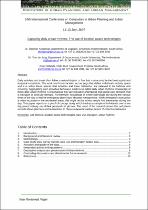JavaScript is disabled for your browser. Some features of this site may not work without it.
- ResearchSpace
- →
- Research Publications/Outputs
- →
- Conference Publications
- →
- View Item
| dc.contributor.author |
Krygsman, S

|
|
| dc.contributor.author |
de Jong, T

|
|
| dc.contributor.author |
Schmitz, P

|
|
| dc.date.accessioned | 2007-10-15T10:39:15Z | |
| dc.date.available | 2007-10-15T10:39:15Z | |
| dc.date.issued | 2007-07 | |
| dc.identifier.citation | Krygsman, S, de Jong, T and Schmitz, P. 2007. Capturing daily urban rhythms: the use of location aware technologies. Computers in urban planning and urban management, 10th International Conference; Iguassu Falls, Brazil, July 11-13, 2007, pp 14 | en |
| dc.identifier.isbn | 9788585205775 | |
| dc.identifier.uri | http://hdl.handle.net/10204/1321 | |
| dc.description | 2007: 10th International Conference , Computers in urban planning and urban management | en |
| dc.description.abstract | Daily activities and travel often follow a natural rhythm or flow that is structured by the fixed spatial and temporal constraints. The work and home location act as pegs that define individual’s activity space and it is within these spaces that activities and travel behaviour are believed to be habitual and recurring. Aggregating such individual behaviour leads to so-called daily urban rhythms. Knowledge of these daily urban rhythms is important as they are indicative of temporal and spatial user demand, that is transport or land use demand. Furthermore, knowledge of where individuals are during the various times of the day is vital for emergency planning or disaster management. While emergency evacuation is often focussed on the residential areas, this might not be where people find themselves during the day. This paper reports on a proof-of-concept study which tracked a sample of individuals over a two day period making use of their personal cell phones. The result of the research shows that cell phone records allow planners and researchers to obtain a dynamic motion picture of collective behaviour. | en |
| dc.description.sponsorship | Silva, antonio Nelson Rodrigues da Souza, Lea Cristina Lucas de | en |
| dc.language.iso | en | en |
| dc.subject | Cell phones | en |
| dc.subject | Location aware technologies | en |
| dc.subject | Land use | en |
| dc.subject | Transport | en |
| dc.subject | Urban rhythms | en |
| dc.subject | Computers in urban planning and urban management, 10th International Conference, Iguassu Falls, Brazil, July 11-13 2007 | en |
| dc.title | Capturing daily urban rhythms: the use of location aware technologies | en |
| dc.type | Conference Presentation | en |
| dc.identifier.apacitation | Krygsman, S., de Jong, T., & Schmitz, P. (2007). Capturing daily urban rhythms: the use of location aware technologies. http://hdl.handle.net/10204/1321 | en_ZA |
| dc.identifier.chicagocitation | Krygsman, S, T de Jong, and P Schmitz. "Capturing daily urban rhythms: the use of location aware technologies." (2007): http://hdl.handle.net/10204/1321 | en_ZA |
| dc.identifier.vancouvercitation | Krygsman S, de Jong T, Schmitz P, Capturing daily urban rhythms: the use of location aware technologies; 2007. http://hdl.handle.net/10204/1321 . | en_ZA |
| dc.identifier.ris | TY - Conference Presentation AU - Krygsman, S AU - de Jong, T AU - Schmitz, P AB - Daily activities and travel often follow a natural rhythm or flow that is structured by the fixed spatial and temporal constraints. The work and home location act as pegs that define individual’s activity space and it is within these spaces that activities and travel behaviour are believed to be habitual and recurring. Aggregating such individual behaviour leads to so-called daily urban rhythms. Knowledge of these daily urban rhythms is important as they are indicative of temporal and spatial user demand, that is transport or land use demand. Furthermore, knowledge of where individuals are during the various times of the day is vital for emergency planning or disaster management. While emergency evacuation is often focussed on the residential areas, this might not be where people find themselves during the day. This paper reports on a proof-of-concept study which tracked a sample of individuals over a two day period making use of their personal cell phones. The result of the research shows that cell phone records allow planners and researchers to obtain a dynamic motion picture of collective behaviour. DA - 2007-07 DB - ResearchSpace DP - CSIR KW - Cell phones KW - Location aware technologies KW - Land use KW - Transport KW - Urban rhythms KW - Computers in urban planning and urban management, 10th International Conference, Iguassu Falls, Brazil, July 11-13 2007 LK - https://researchspace.csir.co.za PY - 2007 SM - 9788585205775 T1 - Capturing daily urban rhythms: the use of location aware technologies TI - Capturing daily urban rhythms: the use of location aware technologies UR - http://hdl.handle.net/10204/1321 ER - | en_ZA |






